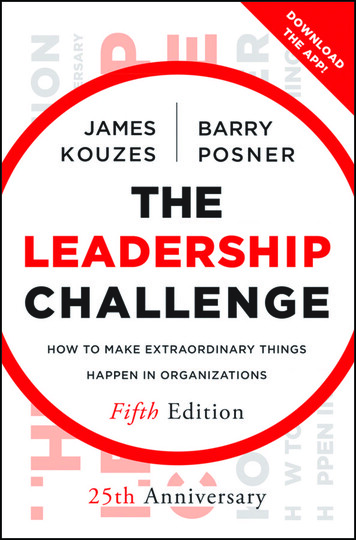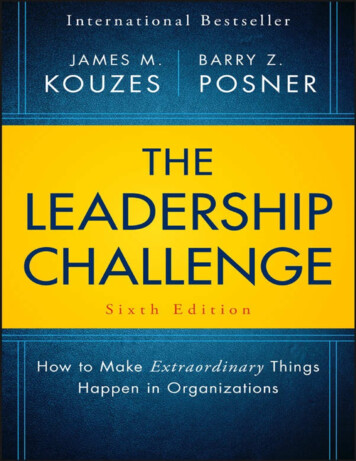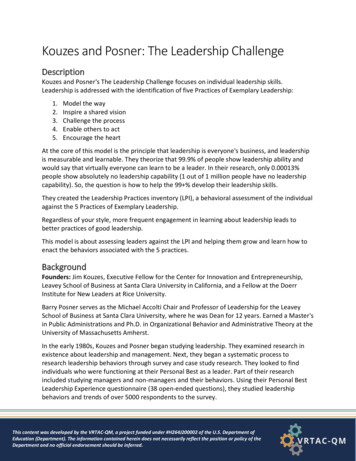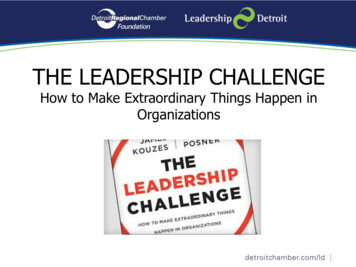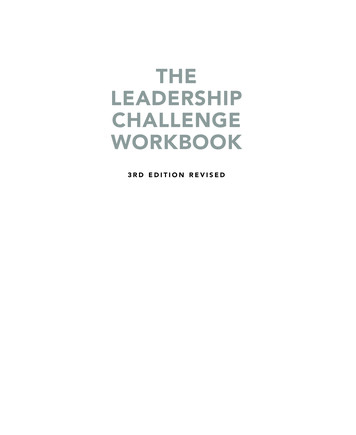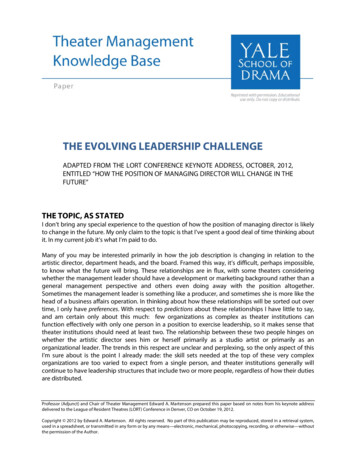
Transcription
THE EVOLVING LEADERSHIP CHALLENGEADAPTED FROM THE LORT CONFERENCE KEYNOTE ADDRESS, OCTOBER, 2012,ENTITLED “HOW THE POSITION OF MANAGING DIRECTOR WILL CHANGE IN THEFUTURE”THE TOPIC, AS STATEDI don’t bring any special experience to the question of how the position of managing director is likelyto change in the future. My only claim to the topic is that I’ve spent a good deal of time thinking aboutit. In my current job it’s what I’m paid to do.Many of you may be interested primarily in how the job description is changing in relation to theartistic director, department heads, and the board. Framed this way, it’s difficult, perhaps impossible,to know what the future will bring. These relationships are in flux, with some theaters consideringwhether the management leader should have a development or marketing background rather than ageneral management perspective and others even doing away with the position altogether.Sometimes the management leader is something like a producer, and sometimes she is more like thehead of a business affairs operation. In thinking about how these relationships will be sorted out overtime, I only have preferences. With respect to predictions about these relationships I have little to say,and am certain only about this much: few organizations as complex as theater institutions canfunction effectively with only one person in a position to exercise leadership, so it makes sense thattheater institutions should need at least two. The relationship between these two people hinges onwhether the artistic director sees him or herself primarily as a studio artist or primarily as anorganizational leader. The trends in this respect are unclear and perplexing, so the only aspect of thisI’m sure about is the point I already made: the skill sets needed at the top of these very complexorganizations are too varied to expect from a single person, and theater institutions generally willcontinue to have leadership structures that include two or more people, regardless of how their dutiesare distributed.Professor (Adjunct) and Chair of Theater Management Edward A. Martenson prepared this paper based on notes from his keynote addressdelivered to the League of Resident Theatres (LORT) Conference in Denver, CO on October 19, 2012.Copyright 2012 by Edward A. Martenson. All rights reserved. No part of this publication may be reproduced, stored in a retrieval system,used in a spreadsheet, or transmitted in any form or by any means—electronic, mechanical, photocopying, recording, or otherwise—withoutthe permission of the Author.
THEATER MANAGEMENT KNOWLEDGE BASE YALE SCHOOL OF DRAMATHE TOPIC, RESTATEDThis point shows the way to a modest amendment to the question that is today’s topic: whatadditional skill sets will be required of theater leadership structures in the future? This can be a morefruitful way to define the topic, because there’s a framework for talking about it and reachingconclusions with some degree of confidence. I’ll explain my thought process in a bit, but first, here aremy conclusions about the additional skill sets that will be required in the leadership of our theaters inthe future.First, theater leaderships will have an enhanced ability to manage change productively, in order tobuild a bigger capacity for adaptation. To manage organizational culture so that stability and creativeflexibility can be valued equally is the last frontier in the development of our work as a profession. Thiswill involve the ability to share information and decision making more broadly than before, and tomanage disagreement and conflict in more supple and productive ways.Second, theater leaderships will have an enhanced ability to function in a data-driven world, throughmore aggressive collection of data and more systematic analytical processes. These analyticalprocesses will be informed by enhanced familiarity with the concepts and methods of economics,psychology, and sociology that help us understand the behavior of organizations and groups.Third, theater leaderships will have an enhanced ability to persuade through the power of ideas andcogent argument, relying less on the authority of position. This ability will be engaged both internally,as decision-making is more truly shared between and among executives and board members, andexternally, as leaders take more responsibility for influencing the direction of the field as a whole. Thiswill be the most visible change, as theater leaders become thought leaders for the field, participatingin a marketplace of ideas that now is inhabited almost exclusively by funders, GIA, and an emergingclass of aspiring cultural policy makers in academia and the blogosphere. I loved seeing Michael Masoengage with Diane Ragsdale about the role and responsibilities of institutions after last summer’s TCGConference, because that’s the kind of thing I foresee occurring on a more regular basis.I’ve summarized these conclusions very briefly here, in the interest of time, but don’t want to minimizethem on that account. Indeed, it’s worth noting that the variety of changes in practices, attitudes, andbudget allocations associated with these developments will be significant. For this reason, it’simportant for me to explain how I reached these conclusions so that you can judge them foryourselves.PROBLEMS SOLVED AND PROBLEMS UNSOLVEDI once heard a smart Harvard professor say that every great industrial innovation has had more impactin its second 40 years than in its first 40. Apparently, industry leaders find ways in the second 40 yearsto solve problems that seemed intractable while the innovation was getting itself established on solidground. This way of looking back on the phenomenon of the nonprofit theater institution seemsinstructive. For one thing, the idea of an institutional meeting ground for artists and audiences is oneof the true innovations in the history of the art form. For another, given how much energy, sweat, andmoney has been devoted to establishing the institutions with some degree of stability, it seemsbizarre to think of their futures in any other way than capitalizing artistically on the strength they’vePage 2 of 8Do not copy or distribute without permission.
THEATER MANAGEMENT KNOWLEDGE BASE YALE SCHOOL OF DRAMAbuilt. They are here to stay, and those who think otherwise aren’t thinking clearly. The only questionworth thinking about is what role theater institutions will play in the larger theatrical ecology.I place the beginning of my 40-year timeline in the mid-1960s, despite the fact that the regionaltheater movement began earlier. The founding at that time of what Joe Zeigler called ‘oak tree’theaters like the Guthrie, the Taper, and Seattle Rep coincided with big developments at previouslyestablished ‘acorn’ theaters like the Alley and the Arena to give substance to the vision of regionaltheaters as institutions, which had not been essential to the regional theater idea. 1 They, and all therest, were created to solve two big problems that emerged during the previous 40 years. At thepinnacle of the Broadway system, in the 1926-1927 season, there were more than 250 productions,including just shy of 200 new plays. That peak of activity fell off during the Depression and World WarII, and by the 1950s it had declined by roughly 80%. The national touring distribution and stock feedersystems collapsed with it. Thus the two problems that combined to justify the need for nonprofitregional theater institutions: people in towns across the country no longer had access to professionaltheater, and the total volume of work was insufficient to enable a critical mass of professionals tomake a life in the theater.Today, the problem of access to quality theater productions is almost completely solved, with adecentralized network of independent institutions, alternative theaters, and touring presentersproviding a broad variety of experiences to populations just about everywhere, with an impressivedegree of stability. This makes a look back at the composition of the 1926-1927 Broadway seasoninteresting; it allows us to compare what we have now with what the Broadway system produced atits peak. The 263 productions that year included crowd-pleasing musicals and comedies, to be sure,but what outstanding shows they were: Show Boat, Strike Up the Band, and The Royal Family, amongothers. But it also included four plays by Shakespeare, The Plough and the Stars, The BrothersKaramazov, An Enemy of the People, The Doctor’s Dilemma, and even Danton’s Death. This slate soundsmuch like a regional theater season to me, and I go so far as to say that were Broadway still able todeliver this sort of work to audiences around the country, there would have been little need for thegiant national and local investments required to establish our nonprofit theater institutions. Or to putthat another way, our institutions were started with the aid of revolutionary fervor, but in retrospect itlooks to me as if they function as replacements for what Broadway once was rather than alternativesto it.Our success in solving the problem of sustaining a critical mass of professionals is more mixed. Thereare more productions, including of new plays, than ever before, and the number of opportunities towork in them therefore is very high. But that’s in the context of a freelance environment very differentfrom the steady employment and opportunities to develop as artists that was hoped for at thebeginning of the regional theater movement and is largely missing today. In this respect, theinstitutional theaters have been an imperfect replacement for the Broadway system as it once was,because even though it was a freelance environment, too, there was much more community andcontinuity of artistic association than now. Succinctly stated, the problem is that theaters generallytake little, if any, responsibility for developing the talent they will come to depend on. This makes1Joseph Wesley Zeigler: Regional Theatre: The Revolutionary Stage (Minneapolis: University of Minnesota Press,1973).Page 3 of 8Do not copy or distribute without permission.
THEATER MANAGEMENT KNOWLEDGE BASE YALE SCHOOL OF DRAMAunderstandable economic sense in the short-term horizons most managements live in, but it clearlywill be self-defeating in the long run. Few artists now have what came to be called an artistic home,and of course that became a tarnished term because it was used as ammunition in a blame game. Theblame game is unhelpful, because the whole system is at fault. Even more important, the blame gameis unhelpful because it obscures a correct framing of the problem and therefore diverts thinking awayfrom solutions. The reality is that making a life in the theater is very difficult for the vast majority ofartists, including a great many of those whose talents sustain the institutions’ work on a regular basis.What would be much more helpful than the blame game is the realization that the difficulty of makinga life in the theater is a problem in which the theaters have a powerful, self-interested stake.PROBLEMS TO BE SOLVED IN THE NEXT 40 YEARSThis, then, is the first of four problems that have emerged during the 40 years that began in the mid 1960s and are now clearly recognizable. From today’s perspective, these problems seem as intractableand daunting as the demise of the entire professional theater system must have seemed to NinaVance in the 1950s. But what I want to emphasize is that these problems will be solved in the next fewdecades, regardless of whether theater leaderships influence the solutions instead of waiting forfunders and self-designated cultural policy-makers to fashion them. If theater leaders do participateeffectively, it will be because they have accumulated the needed skill sets.The first of these problems, as I said, is whether a theatrical profession will survive to practice the art ata high level of skill, or if the art form will become, once again, an amateur pursuit. Please understandthat I believe amateurism—doing something for the love of it—is a noble thing, and I cast noaspersions. But theater-making started aspiring to a higher level of skill through professionalism in thetime of Shakespeare, with hopes for full-time occupation to lead to greater precision in performanceand deeper insights into meaning. In their landmark 1960s work that established the economic basisfor philanthropic support for the professional performing arts, Baumol and Bowen warned that ifphilanthropic support didn't keep up with an ever-rising income gap, we would begin to see cuts inthe quantity or quality of output, or a rising tide of amateur practice. 2 We've actually seen both, withartistic deficits such as fewer productions of large-scale work, declining cast sizes in new plays, andfewer scene and costume changes. But we've also seen a re-emergence of the starving artist as aromantic image, the validation of employment for little or no pay by grants no longer tied to artistcompensation, and the attempt to confer respectability on unpaid employment by the creation ofbooks and papers glorifying something called the pro-Am movement. This movement is perverselydefined as amateurs working to professional standards, when it clearly functions to co-opt the label ofprofessionalism by bringing the standard of work down to the level that amateurs can achieve. Ifartists are willing to work for free, there will be producers willing to employ them for free. Becausesome of them do very interesting work, funders are becoming accustomed to obtaining rewardingartistic results for relatively small sums, and the price of producing is driven down to the levelaffordable only to those who are willing to make their living some other way. And so we’re seeing avicious cycle of decline, in which people are forced to choose between their pride in beingprofessionals and the ability to rehearse and perform regularly. And of course they are willing to workfor free, because the drive to perform is part of their nature. They thus become the first and most2William Baumol and William Bowen: Performing Arts, The Economic Dilemma (New York: The Twentieth CenturyFund, 1966).Page 4 of 8Do not copy or distribute without permission.
THEATER MANAGEMENT KNOWLEDGE BASE YALE SCHOOL OF DRAMAactive members of a conspiracy of convenience that includes their unions, producers, and funders.Everybody laments it, but no one moves to break the cycle. If the cycle isn’t broken somehow, theamateur ideal will take hold and the concept of a profession will become empty of meaning. Already,young artists doubt that it will be possible to make any sort of a living in the theater, and it won't belong before doubt turns to certainty. One way or the other—via concerted action or continuedinaction—this question will be resolved in the next decade or two. And it’s important to make thisdistinction: it’s the profession that’s in danger, not the art form.The second question that will get resolved in this 40-year period is the deteriorating economicstructure of the industry, which is the result of over-population due to a high rate of new entrants anda low rate of exits. Rocco Landesman did us a huge favor when he said there are too many theaters,because he was the first official with a pulpit to give this problem a name. 3 But it is a problem thatisn't specific to the theater or the arts; it’s true in many corners of the nonprofit sector. Here are threenumbers to illustrate this issue, from a 17-year period that almost certainly is representative of theentire 40 years since the mid-1960s.4 Between 1989 and 2005, total revenues for the nation's nonprofitarts, culture, and humanities sector increased by 162%; that's a compound annual growth rate of 5.8%,an enviable record by the standard of most industries. But the population of organizations in thesector also increased by 137% (to a total of 29,000), undeterred by a recession and the massivedislocation of philanthropy after 9/11. After factoring out inflation, the average revenues per nonprofitarts and culture organization were 16% smaller at the end of this period than at the beginning, with allthat says about declining purchasing power and reduced capacity to make or present culture. Thisoutcome was the direct result of an expansionist policy adopted by the most influential funders in the1960s, when lack of access to art was the national problem, and that policy has never gone away. Asan industry we have used – and still use – increasing revenues to create new organizations rather thanto enhance artistic capacity in existing organizations. Put yet another way, we're accepting cuts inartistic capacity—artistic deficits—for the sake of new organizations coming into an already crowdedfield. While continuing to see the arts through an expansionist lens, big foundations long ago beganto see that substantial new investments in the arts were unlikely to yield advancement of the art form;the problems just seem to get bigger regardless of how much money is put into play. Finding somemeans of restraining growth in the population of arts organizations in order to focus resources ongrowing their artistic capacity is becoming increasingly necessary – a new national policy, in effect. Butthe problem at the moment is that no one knows how to do it, or even to begin a conversation thatmight actually get somewhere. As our friend Marian Godfrey has said, a new policy is needed but thefoundations that helped build the field and now agree that it is overbuilt won't cut it back becausethat's “just not philanthropic.”5 The NEA can't do it, either, and it could tear the national serviceorganizations apart if they were to take the lead.However the rationalization is accomplished, it will have at its center a clarified role for institutions anda revised funder outlook about them. The institutions are not just here to stay; they possess the bulk of3Widely‐reported remarks at an Arena Stage conference, January 2011.4Data compiled by Hannah Grannemann from the National Center for Charitable Statistics database in 2007.5Yale Theater Management Knowledge Base: The Ecology of Culture – A Conversation with Marian A. Godfrey(2010).Page 5 of 8Do not copy or distribute without permission.
THEATER MANAGEMENT KNOWLEDGE BASE YALE SCHOOL OF DRAMAthe field's capacity to deliver culture to audiences. That capacity has been purchased at too high aprice to walk away from, so a renewed artistic leadership role for institutions will receive support whenthe institutions re-claim it.The third big question that will get resolved is board responsibility for mission drift, which seems tooccur especially at times of leadership succession in what is now a well-recognized pattern. Boards,even those that include accomplished corporate executives who fully understand the value of distinctbrand identity, frequently make the mistake of choosing leaders who will move organizations in newdirections instead of strengthening the existing directions that have made them successful. Thistendency can and will be overcome, because it must be. Boards in other values-driven fields are goodat putting high value on the aspects of their organizations that make them distinct, so theater boardscan be, too. There's some crucial piece of understanding that seems to be missing, and once it's foundthe way will be clear; it may have something to do with a false impression that the mission is "owned"by the staff leaders rather than the board.The fourth and last problem that will be solved in coming decades is the lack of a coherent policyprocess. The expansionist policy that emerged in the 1960s was easy to put together compared to thesituation we have today. Then it only needed Nelson Rockefeller, the NEA chairman, Mac Lowry, and afew other foundation executives. And all of those policy makers chose at that time to take their adviceabout specific priorities from leaders of institutions in the field. Today, no small group of decisionmakers could possibly move this rock; their levers are not nearly big enough. Today we don't knowwhere the table is, let alone who is, or should be, seated at it. We know who wants to run it, though:there is an emerging class of self-appointed cultural policy makers in and around Americans for theArts, in the blogosphere, and in academic arts administration programs, who aspire to design thefuture. And we know that leaders of theater institutions aren't part of that conversation.COMING FULL CIRCLEWhat additional skill sets will theater leaderships need in the future? They will be built on top of anaccumulation of skill sets over the previous 40 years—that is quite clear. First, theater leaders learnedhow to run production operations. Then they learned from Danny Newman how to sell subscriptions,and from that elementary base of understanding they developed a sophisticated marketing capacity.Then they learned how to raise money from individuals and other sources outside the NEA and theusual foundation suspects, and to build boards and sink relationships deep into their communities.Then they learned how to manage balance sheets, to build assets as well as balance budgets. Thenthey learned how to do big capital campaigns, create signature buildings, and grow theirendowments. And along the way, they learned how to make successful alliances with other theatersand producers. There's only one remaining skill set that competent leaders need, and that's the abilityto manage organizational culture so as to build a greater capacity for creative flexibility and adaptivechange. This capacity, in turn, depends on a deeper familiarity with the concepts and vocabulary ofsocial science. The process of adding that skill set is already underway; the management toolbox willthen be complete. Beyond that essential management skill, the other remaining challenges won't beat the local level; they'll be at the field, or industry, level. These will be political skills in some ways,exercised individually and as a profession to actively influence through leadership and the power ofideas how the field's future will unfold.Page 6 of 8Do not copy or distribute without permission.
THEATER MANAGEMENT KNOWLEDGE BASE YALE SCHOOL OF DRAMAQ & A FOLLOWING THE TALKQ: Reynold Levy has been talking about the need for new business structures to replace what he callsthe nonprofit model. What’s your reaction to that?A: There’s lots of talk out there about so-called hybrid entities that combine some aspects of for-profitand some aspects of nonprofit. I generally think this is a waste of energy, because I can’t imagine thatthe choice of legal form for a theater enterprise will have much influence over its success or failure.The underlying economic forces described by Baumol and Bowen apply to theater enterpriseregardless of how it’s organized legally. People who think that the problems of financial limitationsand artistic deficits will be fixed miraculously by changing from a 501(c)(3) to some other legal formseem to me to be engaged in a version of denial.Q: It sounded as if you believe that theater managers should move beyond the boundaries of theirinstitutions to become more active in the field as a whole. Am I interpreting you correctly?A: Yes, that’s what I believe. I wouldn’t phrase it as “moving beyond,” though; it seems to me that it’s amatter of enlarging one’s understanding of the range of issues a leader needs to embrace in order torepresent her institution’s interests. The fact is that some of the barriers that stand in the way of anindividual institution’s progress are located at the field, or industry, level rather than within theinstitution itself.Q: I remember how important the Baumol & Bowen book was in the 1960s, but I haven’t heard ittalked about much in recent years.A: It seems bizarre that this foundational text is no longer in print, and that its lessons are beingroutinely ignored. The data sets that were assembled during the research are 50 years old, of course,but the economic frameworks based on the data are no less valid today. The consequences ofignoring them are big: having insufficient resources to maintain artistic capacity leads to artisticdeficits, and the organizations that absorb artistic deficits in order to make payroll are criticized for notproviding artistic leadership to the field.Q: You talked about the difficulties artists have in pursuing a life in the theater, and how theaters needto do more to tend to their development as professionals. What about managers and their careerpaths?A: The general observation is that theaters generally don’t have the capacity to assume responsibilityfor development of the talent on which they will depend. Counter to conventional wisdom, thisobservation applies as much to management talent as to artistic talent. The career path foradvancement from entry level management to leadership used to be quite clear, as early-careerpeople initially served time with a more experienced manager as something like associate managingdirector. Former Center Stage Managing Director Peter Culman was a champion at this. But thatposition doesn’t exist in most places anymore, and the career path to leadership for people with ageneral management perspective is no longer clear.Q: You didn’t mention as a problem the lack of diversity in LORT leaderships, but LORT has justestablished a task force to study the problem. How do you think about this?Page 7 of 8Do not copy or distribute without permission.
THEATER MANAGEMENT KNOWLEDGE BASE YALE SCHOOL OF DRAMAA: Yes, it’s a problem—an important one. I don’t mean to minimize it at all when I say that the long term solution to it lies within the need for theaters to take responsibility for developing the talent onwhich their futures depend. In the short term, I hope the LORT task force can generate some progressin leadership hiring, but I don’t think that progress will be as deep and far-reaching as we’d like untilthere are clearer career pathways to lure and keep talented people.Q: Your emphasis on containing the growth rate in the population of theaters seemed to say that wecouldn’t build field revenues. Wouldn’t that be a possible solution to the problem?A: I do think we would see revenues build if there were a stronger pattern of differentiation amongthe theaters. It’s well known on a general level that lack of differentiation tends to drive down prices,including grant amounts. However, the difficulty of differentiating rises proportionally with crowdingof the population, so crowding not only cuts the PIE into smaller slices but also tends to make the PIEsmaller to begin with. I would say that lack of differentiation is the real problem, driven by over crowding and by mission drift.Q: I’m not sure I follow your emphasis on mission drift as a bad thing. In my theater’s case, the missionhas evolved over the decades in ways that seem critical to the success it has achieved.A. Though generally I would say that missions ought to be relatively unchanging, I would never arguethat they should be immune from re-evaluation. Mission-drift becomes a problem within a theatricalecology when different theaters evolve in the same direction, becoming more alike. Lack ofdifferentiation has real economic consequences for all theaters in a given ecology, with negativeimplications such as declining artistic capacity. Put another way, overcrowding would not be hurtingthe field so much if it hadn’t brought duplication with it.Q: I might be even more pessimistic about who can drive the agenda. LORT works to keep minimumwages and benefits low. TCG prospers in part on growing its membership. When I think about thesechallenges, Pogo’s discovery of the enemy comes to mind.A: Tackling the overcrowding and professionalism issues would create real institutional challenges forTCG, LORT, and any other existing organization designed to represent the field broadly. These issuesrequire leadership, which would imply change, which could be threatening to, or even inimical to theinterests of, some members. Any group that attempts to tackle these would have to be made up ofpeople who want to move the field beyond the present “state of the world,” and who could do soethically within the duty they owe to their stakeholders.Page 8 of 8Do not copy or distribute without permission.
THE EVOLVING LEADERSHIP CHALLENGE ADAPTED FROM THE LORT CONFERENCE KEYNOTE ADDRESS, OCTOBER, 2012, ENTITLED “HOW THE POSITION OF MANAGING DIRECTOR WILL CHANGE IN THE FUTURE” THE TOPIC, AS STATED I don’t bring any special experience to the question of how the p



